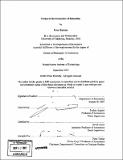| dc.contributor.advisor | Joshua Angrist and David Autor. | en_US |
| dc.contributor.author | Hinrichs, Peter (Peter Laroy) | en_US |
| dc.contributor.other | Massachusetts Institute of Technology. Dept. of Economics. | en_US |
| dc.date.accessioned | 2008-05-19T16:11:12Z | |
| dc.date.available | 2008-05-19T16:11:12Z | |
| dc.date.copyright | 2007 | en_US |
| dc.date.issued | 2007 | en_US |
| dc.identifier.uri | http://hdl.handle.net/1721.1/41713 | |
| dc.description | Thesis (Ph. D.)--Massachusetts Institute of Technology, Dept. of Economics, 2007. | en_US |
| dc.description | Includes bibliographical references. | en_US |
| dc.description.abstract | This thesis consists of three essays on the economics of education.The first chapter estimates the effects of participating in the National School Lunch Program in the middle of the 20th century on educational attainment and adult health. My instrumental variables strategy exploits a change of the formula used by the federal government to allocate funding to the states that was phased in beginning in 1963. Identification is achieved by the fact that different birth cohorts were exposed to different degrees to the original formula and the new formula, along with the fact that the change of the formula affected states differentially by per capita income. Participation in the program as a child appears to have few long-run effects on health, but the effects on educational attainment are sizable. The second chapter studies the issue of racial diversity in higher education. I estimate the effects of college racial diversity on post-college earnings, civic behavior, and satisfaction with the college attended. I use the Beginning Postsecondary Students survey, which allows me to control for exposure to racial diversity prior to college. Moreover, I use two techniques from Altonji, Elder, and Taber (2005) to address the issue of selection on unobservables. Single-equation estimates suggest a positive effect of diversity on voting behavior and on satisfaction with the college attended, but I do not find an effect on other outcomes. Moreover, the estimates are very sensitive to the assumptions made about selection on unobservables.The third chapter studies university affirmative action bans. I use information on the timing of bans along with data from the Current Population Survey (CPS) and the American Community Survey (ACS) to estimate the effects of such bans on college enrollment and educational attainment. | en_US |
| dc.description.abstract | (cont.) I use a triple difference strategy that uses whites as a comparison group for underrepresented minorities and that exploits variation in the bans over states and across time. I find no adverse impact of bans on overall minority college attendance rates and educational attainment relative to whites, and I find no effect of the bans on minority enrollment in public colleges or four-year colleges. | en_US |
| dc.description.statementofresponsibility | by Peter Hinrichs. | en_US |
| dc.format.extent | 109 p. | en_US |
| dc.language.iso | eng | en_US |
| dc.publisher | Massachusetts Institute of Technology | en_US |
| dc.rights | M.I.T. theses are protected by
copyright. They may be viewed from this source for any purpose, but
reproduction or distribution in any format is prohibited without written
permission. See provided URL for inquiries about permission. | en_US |
| dc.rights.uri | http://dspace.mit.edu/handle/1721.1/7582 | en_US |
| dc.subject | Economics. | en_US |
| dc.title | Essays in the economics of education | en_US |
| dc.type | Thesis | en_US |
| dc.description.degree | Ph.D. | en_US |
| dc.contributor.department | Massachusetts Institute of Technology. Department of Economics | |
| dc.identifier.oclc | 222289393 | en_US |
